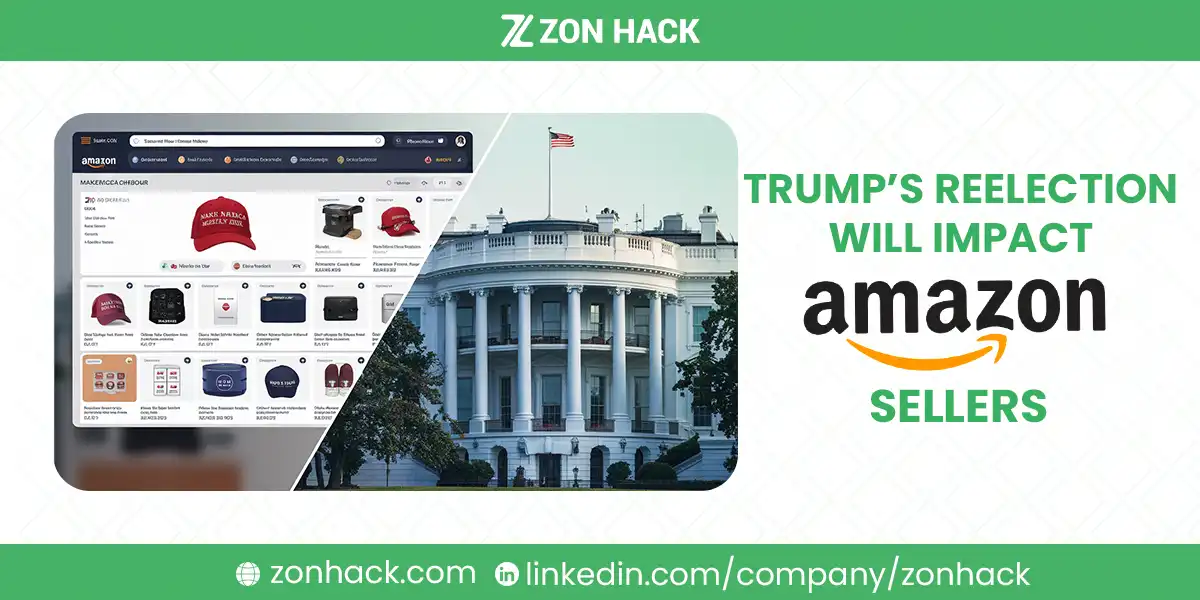The 2024 reelection of Donald Trump is set to have far-reaching implications for the e-commerce industry. Trump’s previous term had a notable impact on e-commerce through trade tariffs, tax reforms, and regulations that shaped how U.S.-based businesses interacted with global markets. As he takes office again in 2024, sellers should expect a continued emphasis on protectionist trade measures, “Buy American” initiatives, and potential shifts in e-commerce regulations – all of which can influence supply chains, costs, and even consumer demand.
Trump’s Previous Economic Policies and Their Impact on Amazon Sellers
Trump’s first term significantly affected e-commerce, particularly in areas of trade tariffs, tax reform, and regulatory pressure on big tech. These policies directly impacted how Amazon sellers sourced products, handled taxes, and managed competition.
U.S.-China Trade War and Tariffs (2018)
Trump imposed tariffs of up to 25% on $250 billion worth of Chinese goods in 2018. This impacted many Amazon sellers who sourced products from China, raising the costs of goods imported from China.
For example, sellers saw increased prices for electronics, home goods, and apparel, forcing them either to absorb the extra cost or raise their retail prices. In 2020, imported goods from China increased by 14% despite the tariffs, highlighting the significant impact of these policies.
Corporate Tax Cuts (2017)
The Tax Cuts and Jobs Act, signed into law in December 2017, lowered the corporate tax rate from 35% to 21%, benefiting large corporations like Amazon. For smaller Amazon sellers, the impact varied based on business size, but the general corporate tax cut provided relief to larger businesses that saw immediate savings.
In 2019, the average tax savings for corporations was approximately $50 billion. Smaller sellers also benefited indirectly from the reduced tax burden on larger retailers, which could result in more competitive pricing.
Push for “America First” Manufacturing (2017–2021)
Trump’s administration made it a priority to incentivize domestic manufacturing through tax credits, grants, and other incentives. For Amazon sellers, this led to a strategic decision: many moved some of their production away from overseas suppliers to U.S.-based manufacturers. Federal tax credits for U.S.-made products ranged from 10% to 25% depending on the industry.
What Amazon Sellers Can Expect from Trump’s 2024 Reelection
Trump’s reelection is expected to bring back many of the same policies from his first term, with potential new initiatives targeted at reshaping the U.S. economy and influencing the Amazon marketplace. Here’s what Amazon sellers should expect:
Tariff Policies and Supply Chain Uncertainty
Trump is likely to continue his tough stance on trade with China, potentially renewing or expanding tariffs. In his first term, tariffs were up to 25% on Chinese goods. A reintroduction of such tariffs could impact specific product categories sold on Amazon, such as electronics, toys, and clothing.
The impact on Amazon sellers could be significant, with some projecting a 10-20% increase in costs for many goods sold on Amazon. For instance, a seller who imports $100,000 worth of goods could see an additional $10,000–$20,000 in costs due to tariff increases.
Reshoring and “Buy American” Initiatives
Trump’s 2024 policies may encourage U.S.-based production even more, possibly through new incentives for domestic manufacturers. This could include tax rebates or grants ranging from $5,000 to $50,000 for companies that reshore jobs.
Sellers manufacturing in the U.S. may see production costs rise, but they could benefit from these government incentives. By 2025, reshoring could lead to a 10% to 15% reduction in manufacturing costs due to the benefits of proximity and reduced shipping costs.
Tax Changes and Corporate Incentives
Tax policies are likely to favor larger businesses again. Amazon’s taxes would be influenced by the corporate tax rate, potentially remaining at 21% or lower. However, smaller sellers might not receive the same benefits, potentially causing uneven competition.
For small to medium-sized Amazon businesses, expected changes may include lower tax thresholds for deductions and more stringent reporting requirements for businesses making over $25 million annually.
E-commerce Regulations and Sales Tax Requirements
One of the key changes from Trump’s 2017–2021 administration was the push for greater sales tax collection for online sellers. By 2024, these regulations may tighten further, with all 50 states requiring Amazon to collect state sales tax.
This shift could increase the administrative burden on sellers, with some estimates suggesting that the average cost of compliance for small businesses could rise by $2,000–$5,000 per year. Sellers may need to adapt by adopting more advanced tax automation tools.
Possible Impact on Amazon’s Business Practices
Trump’s administration frequently criticized Amazon’s competitive practices, potentially leading to increased regulatory scrutiny on the tech giant. Although there is no immediate indication that antitrust actions will intensify, Amazon sellers might experience higher fees or adjustments in Amazon’s marketplace policies.
A recent estimate by the Federal Trade Commission (FTC) indicated that U.S. antitrust probes into tech companies could increase compliance costs for large retailers by up to $10 billion in the next 5 years. This might trickle down to sellers through increased fees and higher operational costs.
How Amazon Sellers Can Navigate This Changing Landscape
As we prepare for these changes, Amazon sellers should consider the following strategies:
Diversify Supply Chains
To mitigate the impact of tariffs or trade restrictions, sellers should consider diversifying their suppliers. This can help mitigate the risk of supply chain disruptions or price hikes due to tariffs. For instance, switching to suppliers in countries such as Vietnam, India, or Mexico could reduce tariff-related costs by up to 15%–20%. Using a product sourcing service that specialize in diverse sourcing channels can also help you diversify your supply.
Emphasize U.S.-Made Products
With Trump’s focus on reshoring, there may be a growing consumer preference for domestic goods. Sellers offering U.S.-made products can market them as “Made in America,” a distinction that can appeal to a significant portion of the American public. U.S.-made products typically have a price premium, and some products see up to 20% higher sales due to the “Buy American” sentiment.
Prepare for Increased Tax and Regulatory Compliance
Sellers should expect more complex tax compliance due to expanding state sales tax laws. Utilizing automated tax services like Avalara or TaxJar can help streamline operations and avoid costly fines. Additionally, tax professionals who specialize in e-commerce may be essential for managing new federal and state regulations.
Bottom Line
Trump’s second term will likely bring a combination of familiar and new policies that Amazon sellers must navigate carefully. While the impact of tariff changes and reshoring policies may create challenges, sellers who proactively adapt by diversifying suppliers, emphasizing U.S.-made products, and staying compliant with regulations will be better positioned to thrive. For Amazon sellers, understanding and preparing for potential shifts will be essential in maximizing profitability in a changing economic landscape.




